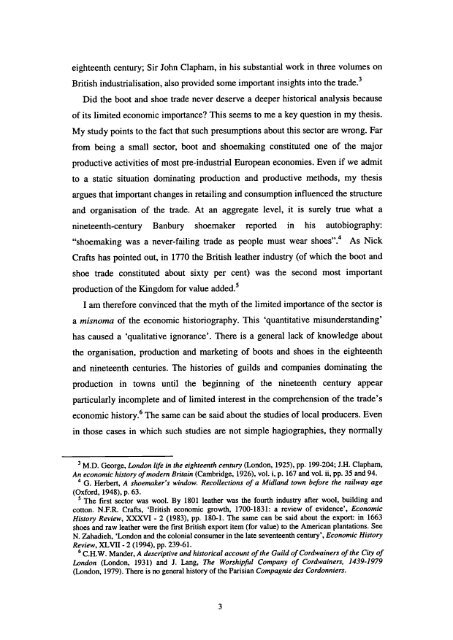The Boot and Shoe Trades in London and Paris in the Long Eighteenth Century
The Boot and Shoe Trades in London and Paris in the Long Eighteenth Century
The Boot and Shoe Trades in London and Paris in the Long Eighteenth Century
Create successful ePaper yourself
Turn your PDF publications into a flip-book with our unique Google optimized e-Paper software.
eighteenth century; Sir John Clapham, <strong>in</strong> his substantial work <strong>in</strong> three volumes on<br />
British <strong>in</strong>dustrialisation, also provided some important <strong>in</strong>sights <strong>in</strong>to <strong>the</strong> trade.3<br />
Did <strong>the</strong> boot <strong>and</strong> shoe trade never deserve a deeper historical analysis because<br />
of its limited economic importance? This seems to me a key question <strong>in</strong> my <strong>the</strong>sis.<br />
My study po<strong>in</strong>ts to <strong>the</strong> fact that such presumptions about this sector are wrong. Far<br />
from be<strong>in</strong>g a small sector, boot <strong>and</strong> shoemak<strong>in</strong>g constituted one of <strong>the</strong> major<br />
productive activities of most pre-<strong>in</strong>dustrial European economies. Even if we admit<br />
to a static situation dom<strong>in</strong>at<strong>in</strong>g production <strong>and</strong> productive methods, my <strong>the</strong>sis<br />
argues that important changes <strong>in</strong> retail<strong>in</strong>g <strong>and</strong> consumption <strong>in</strong>fluenced <strong>the</strong> structure<br />
<strong>and</strong> organisation of <strong>the</strong> trade. At an aggregate level, it is surely true what a<br />
n<strong>in</strong>eteenth-century Banbury shoemaker reported <strong>in</strong> his autobiography:<br />
"shoemak<strong>in</strong>g was a never-fail<strong>in</strong>g trade as people must wear shoes". 4 As Nick<br />
Crafts has po<strong>in</strong>ted out, <strong>in</strong> 1770 <strong>the</strong> British lea<strong>the</strong>r <strong>in</strong>dustry (of which <strong>the</strong> boot <strong>and</strong><br />
shoe trade constituted about sixty per cent) was <strong>the</strong> second most important<br />
production of <strong>the</strong> K<strong>in</strong>gdom for value added.5<br />
I am <strong>the</strong>refore conv<strong>in</strong>ced that <strong>the</strong> myth of <strong>the</strong> limited importance of <strong>the</strong> sector is<br />
a misnoma of <strong>the</strong> economic historiography. This 'quantitative misunderst<strong>and</strong><strong>in</strong>g'<br />
has caused a 'qualitative ignorance'. <strong>The</strong>re is a general lack of knowledge about<br />
<strong>the</strong> organisation, production <strong>and</strong> market<strong>in</strong>g of boots <strong>and</strong> shoes <strong>in</strong> <strong>the</strong> eighteenth<br />
<strong>and</strong> n<strong>in</strong>eteenth centuries. <strong>The</strong> histories of guilds <strong>and</strong> companies dom<strong>in</strong>at<strong>in</strong>g <strong>the</strong><br />
production <strong>in</strong> towns until <strong>the</strong> beg<strong>in</strong>n<strong>in</strong>g of <strong>the</strong> n<strong>in</strong>eteenth century appear<br />
particularly <strong>in</strong>complete <strong>and</strong> of limited <strong>in</strong>terest <strong>in</strong> <strong>the</strong> comprehension of <strong>the</strong> trade's<br />
economic history. 6 <strong>The</strong> same can be said about <strong>the</strong> studies of local producers. Even<br />
<strong>in</strong> those cases <strong>in</strong> which such studies are not simple hagiographies, <strong>the</strong>y normally<br />
M.D. George, <strong>London</strong> l(fe <strong>in</strong> <strong>the</strong> eighteenth century (<strong>London</strong>, 1925), pp. 199-204; J.H. Clapham,<br />
An economic history of modern Brita<strong>in</strong> (Cambridge, 1926), vol. i, p. 167 <strong>and</strong> vol. ii, pp. 35 <strong>and</strong> 94.<br />
"G. Herbert, A shoemaker's w<strong>in</strong>dow. Recollections of a Midl<strong>and</strong> town before <strong>the</strong> railway age<br />
(Oxford, 1948), p. 63.<br />
<strong>The</strong> first sector was wool. By 1801 lea<strong>the</strong>r was <strong>the</strong> fourth <strong>in</strong>dustry after wool, build<strong>in</strong>g <strong>and</strong><br />
cotton. N.F.R. Crafts, 'British economic growth, 1700-1831: a review of evidence', Economic<br />
History Review, XXXVI - 2 (1983), pp. 180-1. <strong>The</strong> same can be said about <strong>the</strong> export: <strong>in</strong> 1663<br />
shoes <strong>and</strong> raw lea<strong>the</strong>r were <strong>the</strong> first British export item (for value) to <strong>the</strong> American plantations. See<br />
N. Zahadieh, '<strong>London</strong> <strong>and</strong> <strong>the</strong> colonial consumer <strong>in</strong> <strong>the</strong> late seventeenth century', Economic History<br />
Review, XLVII - 2 (1994), pp. 239-61.<br />
6<br />
C.H.W. M<strong>and</strong>er, A descriptive <strong>and</strong> historical account of <strong>the</strong> Guild of Cordwa<strong>in</strong>ers of <strong>the</strong> City of<br />
<strong>London</strong> (<strong>London</strong>, 1931) <strong>and</strong> J. Lang, <strong>The</strong> Worshipful Company of Cordwa<strong>in</strong>ers, 1439-1979<br />
(<strong>London</strong>, 1979). <strong>The</strong>re is no general history of <strong>the</strong> <strong>Paris</strong>ian Compagnie des Cordonniers.<br />
3


